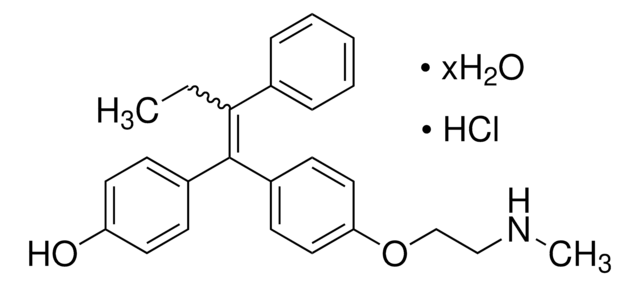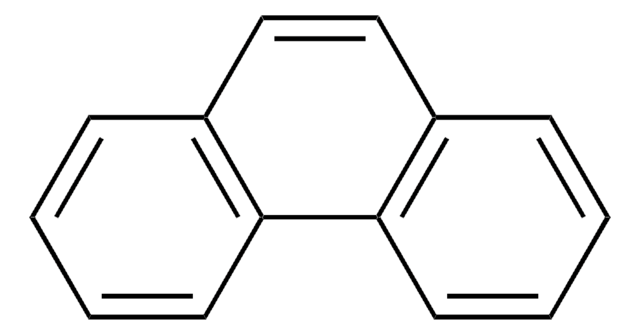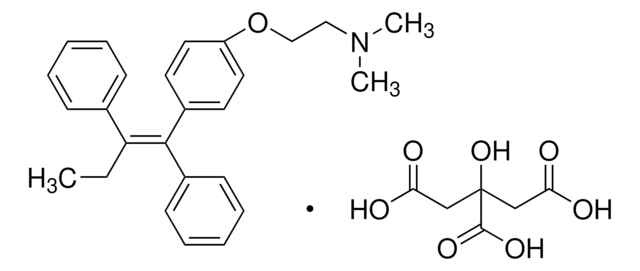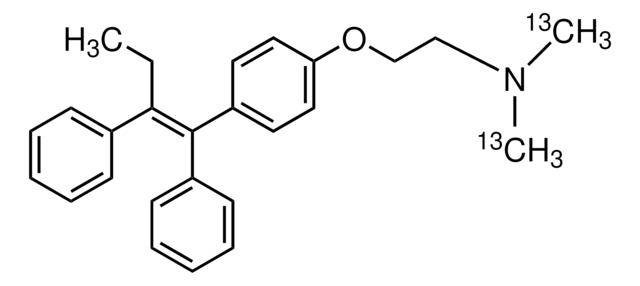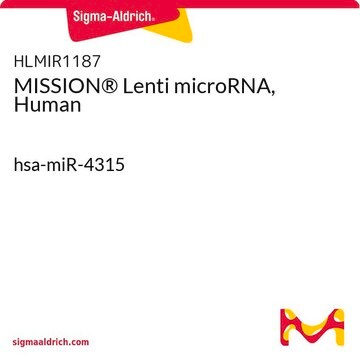579002
(Z)-4-Hydroxytamoxifen
≥99% (HPLC), solid, estrogen receptor modulator, Calbiochem
Sinónimos:
Tamoxifen, 4-Hydroxy-, (Z)-, (Z)-4-Hydroxytamoxifen, 4-OH-TAM, Estrogen Receptor Signaling Regulator II
About This Item
Productos recomendados
Nombre del producto
Tamoxifen, 4-Hydroxy-, (Z)-, A cell-permeable, active metabolite of Tamoxifen that acts as a potent inhibitor of PKC. It is more potent than the parent compound and inhibits PKC by modifying its catalytic domain.
Quality Level
assay
≥99% (HPLC)
form
solid
manufacturer/tradename
Calbiochem®
storage condition
OK to freeze
color
white
solubility
methanol: 10 mg/mL
ethanol: 20 mg/mL (heating may be required)
shipped in
ambient
storage temp.
2-8°C
InChI
1S/C26H29NO2/c1-4-25(20-10-14-23(28)15-11-20)26(21-8-6-5-7-9-21)22-12-16-24(17-13-22)29-19-18-27(2)3/h5-17,28H,4,18-19H2,1-3H3/b26-25-
InChI key
DODQJNMQWMSYGS-QPLCGJKRSA-N
General description
Biochem/physiol Actions
PKC
Warning
Reconstitution
Other Notes
Ye, Q. and Bodell, W.J. 1996. Carcinogenesis 17, 1747.
Laser, R., et al. 1985. Eur. J. Cancer Clin. Oncol. 21, 985.
Jordan, V.C., et al. 1978. J. Toxicol. Environ. Health 4, 364.
Legal Information
signalword
Danger
hcodes
Hazard Classifications
Acute Tox. 4 Oral - Aquatic Acute 1 - Aquatic Chronic 1 - Carc. 1B - Repr. 1B
Storage Class
6.1C - Combustible acute toxic Cat.3 / toxic compounds or compounds which causing chronic effects
wgk_germany
WGK 3
flash_point_f
Not applicable
flash_point_c
Not applicable
Certificados de análisis (COA)
Busque Certificados de análisis (COA) introduciendo el número de lote del producto. Los números de lote se encuentran en la etiqueta del producto después de las palabras «Lot» o «Batch»
¿Ya tiene este producto?
Encuentre la documentación para los productos que ha comprado recientemente en la Biblioteca de documentos.
Los clientes también vieron
Nuestro equipo de científicos tiene experiencia en todas las áreas de investigación: Ciencias de la vida, Ciencia de los materiales, Síntesis química, Cromatografía, Analítica y muchas otras.
Póngase en contacto con el Servicio técnico

